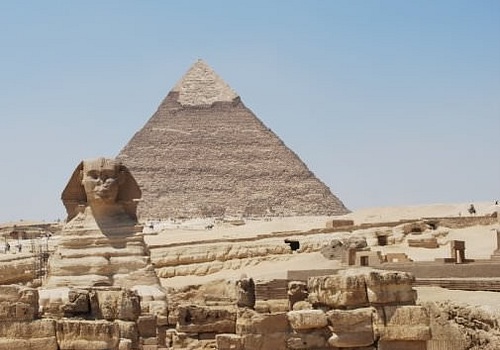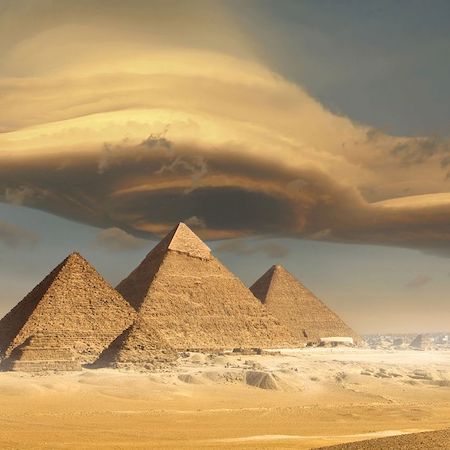About
Giza is the second-largest city in Egypt after Cairo and fourth-largest city in Africa after Lagos, Kinshasa and Cairo. It is the capital of Giza Governate with a total population of 8.8 million as of October 2018. It is located on the west bank of the Nile, 4.9 km southwest of central Cairo, and is a core city of the Greater Cairo metropolis. Giza is most famous as the location of the Giza Plateau, the site of the some of the most imporessive and ancient monuments in the world. Giza is a plateau southwest of modern Cairo which served as the necropolis for the royalty of the Old Kingdom of Egypt. Most famous for the pyramids of Khufu(completed in c. 2560 BCE) and the Great Sphinx(built 2500 BCE),recent excavations on the plateau have revealed numerous private tomb complexes and workers' quarters. The original necropolis of Giza was laid out with amazing precision and skill but, once it became associated with the great kings of Egypt and their pyramids, attracted the attention of less prominent officals of lower rank. These officials had enough money and prestige to buy their way into burial plots at Giza but had no regard for the symmetry of the original schematics and had their tombs dug wherever they found available space. This resulted ina number of grave complexes throughout Giza which would not have been authorized by the kings who built the famous pyramids which, thorughout history, have drawn vistors from around the world.
Pyramids

Although the Giza plateau is most closely associated with the pyramids of Khufu, Khafre, and Menkaure, the site was used as early as the First Dynasty of Egypt as evidenced by the tomb of the king Djet which was found toward the edge of the plateau. Evidence of at least one king from the Second Dynasty (Nynetjer) buried at Giza has also been found. Further, inscriptions relate how king Khufu had to clear many earlier tombs and grave complexes to build the Great Pyramid. What happened to the corpses or the grave goods from those tombs is not known. The Great Pyramid of Khufu (also known as the pyramid of Cheops, the king's Greek name) is the last remaining of the ancient Seven Wonders of the World and rises to a height of 481 feet (147 metres). The pyramid of Khafre is 471 feet tall(144 metres) and that of Menkaure rises to 213 feet (65 metres). The Great Sphinx sits on the eastern side of the plateau apart from the pyramids but it is thought it once was an important part of the pyramid complex which covered the area. The head of the Sphinx is believed by Egyptologists to be that of the king Khafre though others contend that represents Khufu. Further on, the great solar barge of Khufu, which is the oldest intact ship extant, was found buried in a pit near the Great Pyramid in 1954 CE. Dating from c.2500 BCE, the ship is 143 feet (43 metres) long and 19 feet (5.9 metres) wide. Near the Pyramid complex there are a number of smaller structures known as the Queens Pyramids. It is uncertain who was buried beneath these pyramids but evidence suggests they were the tombs of Hetepheres I (Khufu's mother), Meretites (Khufu's wife) and a later queen named Henutsen. The pyramids were once encased in polished limestone which, according to ancient writers, reflected the light of the sun brilliantly. The limestone was stripped away over the years for use in other building projects, most notably the mosques of Cairo. Of the three major pyramids, however, only Menkaure's is seen today without any of its original limestone casing; Khafre's Pyramid retains its casing stones at its apex while Khufu's has a smaller remainder at its base. The sides of all three of the Giza pyramids were oriented astronomically to be precisely north-south and east-west within a small fraction of a degree.
Tombs

The original layout of the necropolis at Giza seems to have been very precise and well-ordered but, after the end of the Old Kingdom, other tombs were dug without regard for the original pattern. Sometimes they were dug above existing tombs, making present-day Giza a wealth of archaeological material. Recent excavations have uncovered tombs of high officials, magistrates, and supervisors of building projects, as well as monuments honoring the Egyptian workers who labored on the pyramids and others who were employed and lived in the immediate vicinity. Largely due to engravings and etchings from the 19th century and early 20th centuries CE (and postcards and calendars of modern times) many people think of the Giza plateau and the pyramids as resting in a remote, wind-swept desert locale, when in reality it sits at the very edge of urban sprawl of Cairo today. In its time it would have also been a center of daily activity with many buildings, colonnades, terraces and shops. The image of the Giza plateau in the modern day is thus vastly different from how it looked during the Fourth Dynasty of Egypt when the pyramids were built. There was a worker's village, which has been discovered and excavated, around 1300 feet (400 meters) south of the Great Sphinx where the laborers who worked on Menkaure's pyramid lived and those who built Khufu's pyramid founded a small village (Khufu's Village) on the far side of the complex.
Climate
Giza experiences a hot desert climate like arid climate (Köppen: BWh). Its climate is similar to Cairo, owing to its proximity. Wind storms can be frequent across Egypt in spring, bringing Saharan dust into the city during the months of March and April. High temperatures in winter range from 16 to 20 °C (61 to 68 °F), while nighttime lows drop to below 7 °C (45 °F). In summer, the highs are 40 °C (104 °F), and the lows can drop to about 20 °C (68 °F). Rain is infrequent in Giza; snow and freezing temperatures are extremely rare. Up to August 2013, the highest recorded temperature was 46 °C (115 °F) on 13 June 1965, while the lowest recorded temperature was 2 °C (36 °F) on 8 January 1966